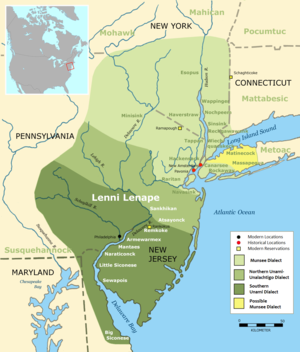
Back Mounseeg Breton Munsee German Munsee Spanish Munsee French Lingua munsee Galician Munsee Croatian Lingua munsee Italian Lengua munsee LMO Munsee NB Lenga munsee PMS
| Munsee | |
|---|---|
| Huluníixsuwaakan Monsii èlixsuwakàn | |
| Native to | Canada; United States |
| Region | now in Ontario; formerly in New York, New Jersey, Pennsylvania |
| Ethnicity | 400 Munsee (1991)[1] |
Native speakers | 2 (2018) |
| Language codes | |
| ISO 639-3 | umu |
| Glottolog | muns1251 |
| ELP | Munsee |
 Munsee is classified as Critically Endangered by the UNESCO Atlas of the World's Languages in Danger | |
| Coordinates: 42.57, -81.879[5] | |
| Person | Monsi, Lënape |
|---|---|
| People | Monsiyok, Lënapeyok |
| Language | Monsii èlixsuwakàn, Lënapei èlixsuwakàn |
| Country | Monsihòkink, Lënapehòkink |

Munsee (also known as Munsee Delaware, Delaware, Ontario Delaware, Delaware: Huluníixsuwaakan, Monsii èlixsuwakàn) is an endangered language of the Eastern Algonquian subgroup of the Algonquian language family, itself a branch of the Algic language family. Munsee is one of two Delaware languages (also known as Lenape languages, after the tribe's autonym). It is very closely related to the Unami Delaware, but the two are sufficiently different that they are considered separate languages. Munsee was spoken aboriginally by Lenape in the vicinity of the modern New York City area in the United States, including western Long Island, Manhattan Island, Staten Island, as well as adjacent areas on the mainland: southeastern New York State, the northern third of New Jersey, and northeastern Pennsylvania.[6][3]
As of 2018, Munsee was spoken only on the Moraviantown Reserve in Ontario, Canada, by two elderly individuals, aged 77 and 90,[7][8][9] making it critically endangered.[5] The language that the individuals speak differs between speakers, each having a personal dialect.[10] There has been interest in learning the language by younger individuals.[11][12]
- ^ Munsee at Ethnologue (18th ed., 2015) (subscription required)
- ^ Pentland 1992, p. 15.
- ^ a b Goddard 1996, p. 5.
- ^ Hammarström, Harald; Forkel, Robert; Haspelmath, Martin; Bank, Sebastian (May 24, 2022). "Delawaran". Glottolog. Max Planck Institute for Evolutionary Anthropology. Archived from the original on October 30, 2022. Retrieved October 29, 2022.
- ^ a b "Munsee". Endangered Languages Project. University of Hawaii at Manoa. April 29, 2020. Archived from the original on June 9, 2023. Retrieved April 29, 2020.
- ^ Goddard 1978a, p. 213.
- ^ Munsee at Ethnologue (15th ed., 2005)

- ^ McDowell, Adam (January 22, 2009). "More than words: Can Canada's dying languages be saved?". National Post. Retrieved May 29, 2009.[dead link]
- ^ "Munsee – Saving Dying Languages". Red Star Cafe, Art and Java for the Masses. January 24, 2009. Archived from the original on October 11, 2017. Retrieved September 23, 2012.
- ^ Goddard, Ives (January 1, 2010). "Linguistic Variation in a Small Speech Community: The Personal Dialects of Moraviantown Delaware". Anthropological Linguistics. 52 (1): 1–48. doi:10.1353/anl.2010.a405139. JSTOR 40929737. S2CID 143391317.
- ^ "The vanishing voice of the Lenape". Star-Ledger. Cambridge, MA. November 17, 2002. Archived from the original on May 4, 2016. Retrieved September 23, 2012.
- ^ "Yoh Lunaapeewak!". yohlunaapeewak.blogspot.com. Archived from the original on February 11, 2017. Retrieved September 23, 2012.